Luxembourg -- at least it's bigger than Lichtenstein (11/10/03)
Last updated 11/13/03
After our invigorating stay with Christophe and Stephanie in Namur, we
headed on our merry way to France through the somewhat small Grand
Duchy of Luxembourg (82km long and 57km wide). Given its small size,
I'm not surprised by my dad's recent comment that he had previously
thought that Luxembourg was "a part of Belgium". Actually during the
reign of Napoleon, this small nation was listed as a French "forestry
department". Although we did not enjoy our stay in Luxembourg as much
as Belgium, Luxembourg City, the millenium-old capital of this dukedom,
offered a vast expanse to walk through and showed that in the end, size
really doesn't matter!
Luxembourg City showcases its historical significance through the
various remains of fortifications (the city was conquered by numerous
European powers, and was rebuilt more than 20 times in 400 years). It
also offers wandering tourists, like yours truly, plenty of
pedestrian-friendly (damn you Amsterdam) paths along bustling city
streets, through forest-like parks, and over impressive, long bridges,
all in
the heart of the city! Three main parts of the city sit at different
elevations (and we are talking high hills separated by low
plains); in one instance, a large park-like area (the Citadel
Gardens) separates the "train-station section" from the Old Town
sector, necessitating the impressive bridges shown below. To get to the
Grund, the third and final district of the town, you are required to
take a lift (elevator -- I'm becoming Europeanized, but I swear that I
will resist the metric system with all my might) to descend from Old
Town. It took us quite a while to figure out exactly where the lift was
located and we ended up going down a set of stairs before realizing
that we needed to use the lift to go all the way down. My question is
this: what do they do in the case of a power outage? Obviously there
are streets that connect the Grund to Old Town, but it's gotta suck if
you're a pedestrian, or if you get stuck in the elevator during one of
those outages... The places we went to and the stuff we saw is shown
below with enough explanations so there's little left for me to add
here. One interesting observation though: this is the first Notre Dame
cathedral that we are visiting, and the next 2 cities also have a
cathedral of the same name. Pretty darn confusing if you ask me, not to
mention a bit boring -- why can't people pick more original names?
Daria's input: "confusing" is,
unfortunately, the first word that comes to my mind when charged with
the task of describing Luxembourg City. This impression is probably due
to our lack of navigating ability more than any innate property of the
town... but we managed to get lost multiple times and never found our
way to the citadel -- Citadelle du St Esprit, this huge area on our map
of the city, seemingly impossible to miss, yet we only saw it once from
across a river, and didn't find any way to approach it. Getting to the
wonderfully sculpted gardens with EU flags, located under Place de la
Constitution but above Citadel Gardens, also took a few attempts.
Another example of confusing nature of Lux would be our visit to the
local internet cafe, CyberGrund, in the Grund district. You see the
sign "CyberGrund" over a door, along with multiple advertisements and
pricelists of this establishment, approach the door, and encounter a
note suggesting that the entrance you're facing is closed off (the X
mark on the floorplan), and you need to go around the corner and use
courtyard entrances 2 or 2A. Okay, so you go there, and discover that
the building is entirely residential and there's no mention of any
internet cafe on its courtyard side. Dazed and confused, you come back
to the street entrance, gather your courage, pull the door handle, walk
in... and see that yes, this is indeed the internet place, and there's
nothing wrong with its front door. Why did they put up the misleading
note? I'm afraid I will never know this, or many other things about
Luxembourg, since I obviously do not jell with this town. However, the
places we managed to reach, like the gardens and bridges shown on
photos below, rewarded us with nice walking experiences.
Pictures
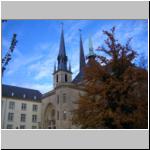
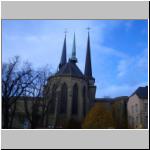 Some views of the Cathédrale Notre
Dame in the city (i.e. Church of
Our Lady who is Mary, mother of Jesus Christ; the audience is asked not
to be offended by this footnote, it just occurred to me that
familiarity with Christian faith is an accident of birth and not a
necessary component of everyone's education). It houses the most
revered idol of the nation (yes,
the Luxembourg nation, which one did you think?) -- the Lady
Comforter of the Afflicted, a small (very small)
statue of the Virgin and Child that
looks like a porcelain doll dressed in green.
Some views of the Cathédrale Notre
Dame in the city (i.e. Church of
Our Lady who is Mary, mother of Jesus Christ; the audience is asked not
to be offended by this footnote, it just occurred to me that
familiarity with Christian faith is an accident of birth and not a
necessary component of everyone's education). It houses the most
revered idol of the nation (yes,
the Luxembourg nation, which one did you think?) -- the Lady
Comforter of the Afflicted, a small (very small)
statue of the Virgin and Child that
looks like a porcelain doll dressed in green.
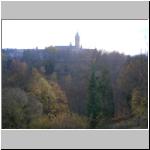

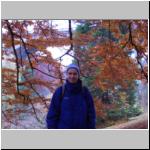

The city is separated into different sections by a vast park-like area
that more resembles a forest with large paths. Replete with trees
changing color and falling leaves, the park offers a nice place for
walking. Just beware of gifts
that might be left on the paths by pet dogs who have become so
urbanized that they prefer concrete walkways to grassy lawns...
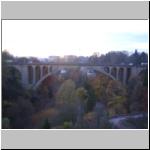
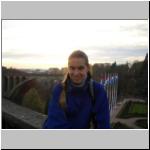
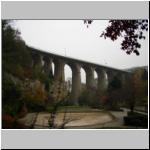 The sections of the city, separated by a vast
valley of trees, are connected by beautiful, impressive bridges
shown here. Some bridges have
train tracks on them, so it's possible to observe that picture-book
image of a long train crossing the deep valley over a tall bridge. The
train we saw managed to cross over pretty fast, so there's no
photograph to back up our claim.
The sections of the city, separated by a vast
valley of trees, are connected by beautiful, impressive bridges
shown here. Some bridges have
train tracks on them, so it's possible to observe that picture-book
image of a long train crossing the deep valley over a tall bridge. The
train we saw managed to cross over pretty fast, so there's no
photograph to back up our claim.
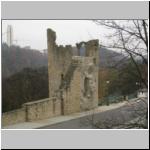

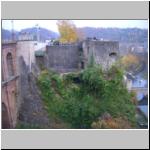 The Bock castle was a mighty fort built by Count Sigefroi,
and now all that remains are these ruins shown above. There's actually much more to these
fortifications ("casemates") than meets the eye: supposedly there's 23
kilometers of underground passages there, but the access to them was
shut off, hence we didn't get a chance to get ourselves lost in the
trenches.
The Bock castle was a mighty fort built by Count Sigefroi,
and now all that remains are these ruins shown above. There's actually much more to these
fortifications ("casemates") than meets the eye: supposedly there's 23
kilometers of underground passages there, but the access to them was
shut off, hence we didn't get a chance to get ourselves lost in the
trenches.

 Some views of the Cathédrale Notre
Dame in the city (i.e. Church of
Our Lady who is Mary, mother of Jesus Christ; the audience is asked not
to be offended by this footnote, it just occurred to me that
familiarity with Christian faith is an accident of birth and not a
necessary component of everyone's education). It houses the most
revered idol of the nation (yes,
the Luxembourg nation, which one did you think?) -- the Lady
Comforter of the Afflicted, a small (very small)
statue of the Virgin and Child that
looks like a porcelain doll dressed in green.
Some views of the Cathédrale Notre
Dame in the city (i.e. Church of
Our Lady who is Mary, mother of Jesus Christ; the audience is asked not
to be offended by this footnote, it just occurred to me that
familiarity with Christian faith is an accident of birth and not a
necessary component of everyone's education). It houses the most
revered idol of the nation (yes,
the Luxembourg nation, which one did you think?) -- the Lady
Comforter of the Afflicted, a small (very small)
statue of the Virgin and Child that
looks like a porcelain doll dressed in green.





 The sections of the city, separated by a vast
valley of trees, are connected by beautiful, impressive bridges
shown here. Some bridges have
train tracks on them, so it's possible to observe that picture-book
image of a long train crossing the deep valley over a tall bridge. The
train we saw managed to cross over pretty fast, so there's no
photograph to back up our claim.
The sections of the city, separated by a vast
valley of trees, are connected by beautiful, impressive bridges
shown here. Some bridges have
train tracks on them, so it's possible to observe that picture-book
image of a long train crossing the deep valley over a tall bridge. The
train we saw managed to cross over pretty fast, so there's no
photograph to back up our claim.

 The Bock castle was a mighty fort built by Count Sigefroi,
and now all that remains are these ruins shown above. There's actually much more to these
fortifications ("casemates") than meets the eye: supposedly there's 23
kilometers of underground passages there, but the access to them was
shut off, hence we didn't get a chance to get ourselves lost in the
trenches.
The Bock castle was a mighty fort built by Count Sigefroi,
and now all that remains are these ruins shown above. There's actually much more to these
fortifications ("casemates") than meets the eye: supposedly there's 23
kilometers of underground passages there, but the access to them was
shut off, hence we didn't get a chance to get ourselves lost in the
trenches.